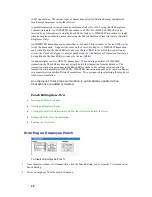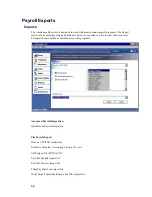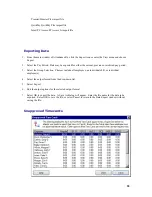
20
Select Save to save your changes. To quit without saving changes, select another option from the
left hand navigation and select No in the Save Changes dialog box. To restore your original
settings, click Refresh in the top right hand corner and select No in the Save Changes dialog box.
P
P
a
a
y
y
P
P
e
e
r
r
i
i
o
o
d
d
The Pay Period Length specifies how often employees will get paid.
To Change the Pay Period Length:
From the main window of Attendance Rx, click the Setup icon or enter the View menu and choose
Setup.
Change the Pay Period Length to the desired setting.
The available choices are
:
•
Weekly
- Employees are paid once per week
•
Bi-weekly
- Employees are paid every two weeks
•
Semi-Monthly
- Employees are paid twice per month
•
Monthly
- Employees are paid once per month
Select Save to save your changes. To quit without saving changes, select another option from the
left hand navigation and select No in the Save Changes dialog box. To restore your original
settings, click Refresh in the top right hand corner and select No in the Save Changes dialog box.
Setting the Next Pay Period Start Date
The Next Pay Period Start Date is the date on which the next pay period will start. Set the Pay
Period Length prior to setting the Next Pay Period Start Date. The next pay period start date must
be greater than the current time and date and less than the current time and date plus the length of
the pay period.
Changing the Next Pay Period Start Date Setting:
•
From the main window of Attendance Rx, click the Setup icon or enter the View menu and choose
Setup
•
Change the Next Pay Period Start Date value to the desired future date.
•
Select Save to save your changes. To quit without saving changes, select another option from the
left hand navigation and select No in the Save Changes dialog box. To restore your original
settings, click Refresh in the top right hand corner and select No in the Save Changes dialog box.
P
P
a
a
y
y
I
I
n
n
t
t
e
e
r
r
v
v
a
a
l
l
R
R
o
o
u
u
n
n
d
d
The Pay Interval Round allows the time worked totals to be rounded and calculated to the nearest
one, five, ten, or fifteen-minute interval.
Example 1:






























